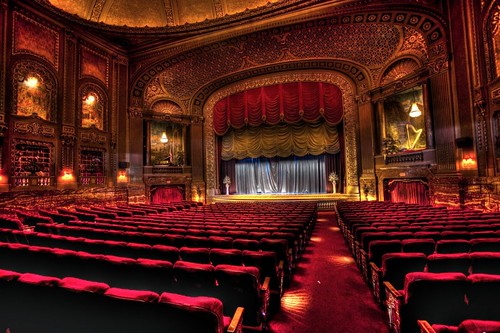Parochialism and historiography
Today's Post has a column on promoting racism through how the Civil War is commemorated through Government proclamation in Virginia. See "Revisionists having a ball with Civil War anniversary" by Courtland Milloy.

HDR photo of the interior of the Bryd Theatre by DMPhoto. (Note that the theater is more threadbare than indicated by the enhanced photo.)

The exhibit shocked me in how it treated the Civil War because it was direct and not about myth, and involved more current interpretations. The exhibit discusses how Richmond's business elite, because the city was the South's most industrialized city, did not favor secession; it covers the creation of the "Lost Cause" myth--which is still the narrative of today's apologists; as well as Segregationist policies and Old South/New South interpretations.
Given how the Smithsonian Institutions are "forced" to interpret history in terms of acceptable beliefs about American Myth, Memory, and National Identity, and how this trickles down in terms of how the local story is told, it was interesting to see. The museum is smaller than say the Pittsburgh History Center, but they cover a lot of ground with the resources they have.
At the VMFA, there is also a great exhibit on the "Special Artists" of the Civil War (Civil War Drawings from the Becker Collection), the artists who drew battle and other scenes from the Civil War, which were published in nationally distributed magazines such as Frank Leslie's Illustrated Weekly, Harper's Weekly, and the Illustrated London News. This exhibit was drawn from the archives of the Leslie Newspaper, which were saved by the paper's art editor, Joseph Baker.

From Frank Leslie's Illustrated Weekly.
The interpretive panels discussed how the drawings were subsequently modified and embellished before printing, in ways to strengthen the message and communicate various positions. It made me consider the published drawings in new ways, that the idea that you can't always believe what you "read" in the newspaper is hardly a new phenomenon.
The fact is that these kinds of exhibits need to be supported by journalists and public intellectuals. When discourse is constrained, key questions get ignored. And frankly, the Washington Post has contributed to this with regard to the Smithsonian Institution, at least in terms of some of the writings of Marc Fisher with regard to the National Museum of the American Indian (see the journal article "The National Museum of the American Indian as cultural sovereignty" from American Quarterly) and the National Museum of American History--in my opinion anyway, he has supported very traditional forms of interpretation, rather than more expansive perspectives. (Note that the writings of Blake Gopnik, with regard to the Smithsonian American Art Museum's censorship of a particular work in the Hide/Seek exhibit have been much different from this standpoint, compared to Fisher.)
But when journalists focus on the Sons of the Confederacy, and not some of the more serious scholarship, interpretation, and presentation, it becomes harder for curators to present more modern narratives that challenge the status quo, not easier... and becomes another reason to question the accuracy of dominant media institutions.
Labels: cultural heritage/tourism, historiography, local history, media and communications, urban history



0 Comments:
Post a Comment
<< Home